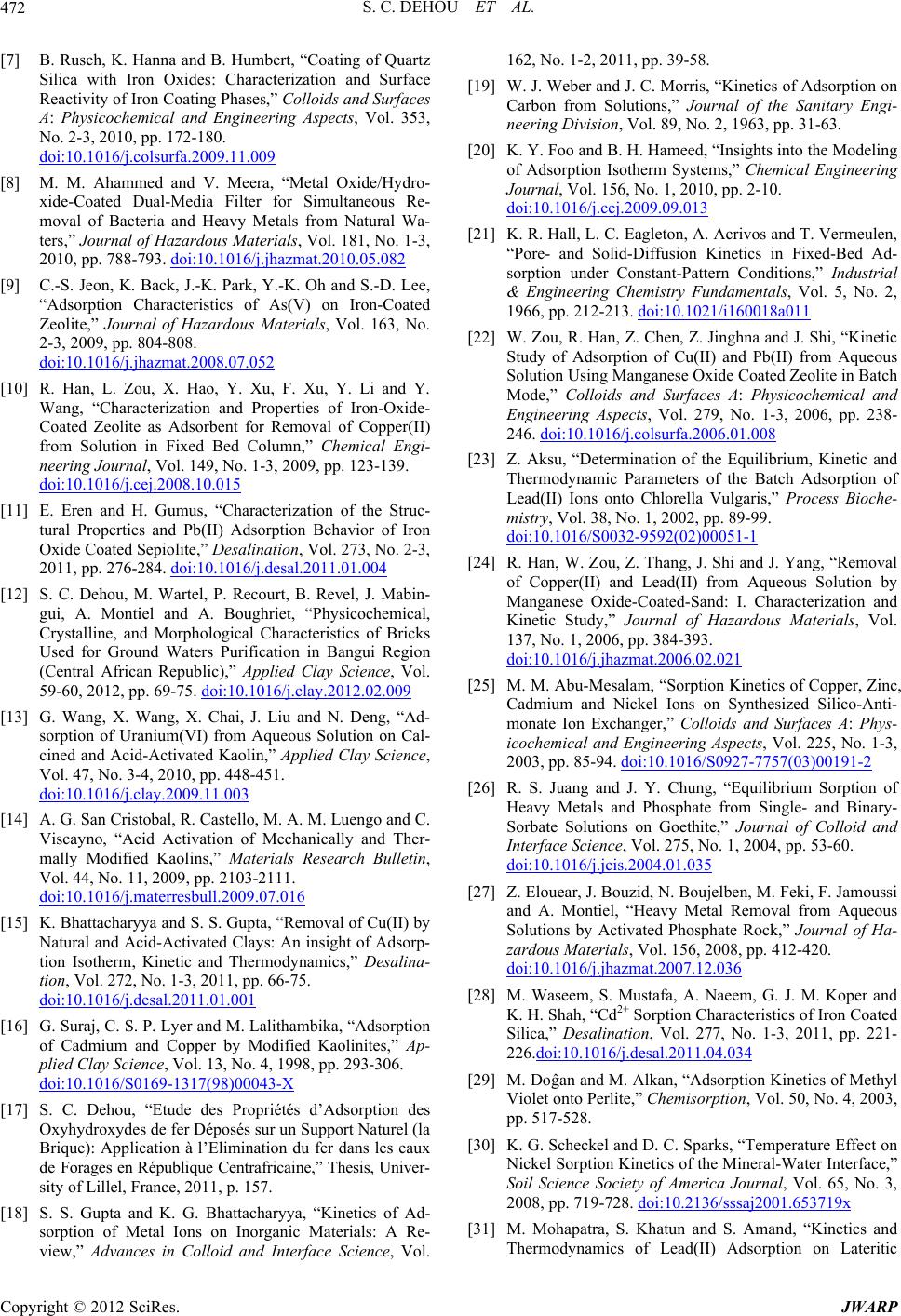
S. C. DEHOU ET AL.
472
[7] B. Rusch, K. Hanna and B. Humbert, “Coating of Quartz
Silica with Iron Oxides: Characterization and Surface
Reactivity of Iron Coating Phases,” Colloids and Surfaces
A: Physicochemical and Engineering Aspects, Vol. 353,
No. 2-3, 2010, pp. 172-180.
doi:10.1016/j.colsurfa.2009.11.009
[8] M. M. Ahammed and V. Meera, “Metal Oxide/Hydro-
xide-Coated Dual-Media Filter for Simultaneous Re-
moval of Bacteria and Heavy Metals from Natural Wa-
ters,” Journal of Hazardous Materials, Vol. 181, No. 1-3,
2010, pp. 788-793. doi:10.1016/j.jhazmat.2010.05.082
[9] C.-S. Jeon, K. Back, J.-K. Park, Y.-K. Oh and S.-D. Lee,
“Adsorption Characteristics of As(V) on Iron-Coated
Zeolite,” Journal of Hazardous Materials, Vol. 163, No.
2-3, 2009, pp. 804-808.
doi:10.1016/j.jhazmat.2008.07.052
[10] R. Han, L. Zou, X. Hao, Y. Xu, F. Xu, Y. Li and Y.
Wang, “Characterization and Properties of Iron-Oxide-
Coated Zeolite as Adsorbent for Removal of Copper(II)
from Solution in Fixed Bed Column,” Chemical Engi-
neering Journal, Vol. 149, No. 1-3, 2009, pp. 123-139.
doi:10.1016/j.cej.2008.10.015
[11] E. Eren and H. Gumus, “Characterization of the Struc-
tural Properties and Pb(II) Adsorption Behavior of Iron
Oxide Coated Sepiolite,” Desalination, Vol. 273, No. 2-3,
2011, pp. 276-284. doi:10.1016/j.desal.2011.01.004
[12] S. C. Dehou, M. Wartel, P. Recourt, B. Revel, J. Mabin-
gui, A. Montiel and A. Boughriet, “Physicochemical,
Crystalline, and Morphological Characteristics of Bricks
Used for Ground Waters Purification in Bangui Region
(Central African Republic),” Applied Clay Science, Vol.
59-60, 2012, pp. 69-75. doi:10.1016/j.clay.2012.02.009
[13] G. Wang, X. Wang, X. Chai, J. Liu and N. Deng, “Ad-
sorption of Uranium(VI) from Aqueous Solution on Cal-
cined and Acid-Activated Kaolin,” Applied Clay Science,
Vol. 47, No. 3-4, 2010, pp. 448-451.
doi:10.1016/j.clay.2009.11.003
[14] A. G. San Cristobal, R. Castello, M. A. M. Luengo and C.
Viscayno, “Acid Activation of Mechanically and Ther-
mally Modified Kaolins,” Materials Research Bulletin,
Vol. 44, No. 11, 2009, pp. 2103-2111.
doi:10.1016/j.materresbull.2009.07.016
[15] K. Bhattacharyya and S. S. Gupta, “Removal of Cu(II) by
Natural and Acid-Activated Clays: An insight of Adsorp-
tion Isotherm, Kinetic and Thermodynamics,” Desalina-
tion, Vol. 272, No. 1-3, 2011, pp. 66-75.
doi:10.1016/j.desal.2011.01.001
[16] G. Suraj, C. S. P. Lyer and M. Lalithambika, “Adsorption
of Cadmium and Copper by Modified Kaolinites,” Ap-
plied Clay Science, Vol. 13, No. 4, 1998, pp. 293-306.
doi:10.1016/S0169-1317(98)00043-X
[17] S. C. Dehou, “Etude des Propriétés d’Adsorption des
Oxyhydroxydes de fer Déposés sur un Support Naturel (la
Brique): Application à l’Elimination du fer dans les eaux
de Forages en République Centrafricaine,” Thesis, Univer-
sity of Lillel, France, 2011, p. 157.
[18] S. S. Gupta and K. G. Bhattacharyya, “Kinetics of Ad-
sorption of Metal Ions on Inorganic Materials: A Re-
view,” Advances in Colloid and Interface Science, Vol.
162, No. 1-2, 2011, pp. 39-58.
[19] W. J. Weber and J. C. Morris, “Kinetics of Adsorption on
Carbon from Solutions,” Journal of the Sanitary Engi-
neering Division, Vol. 89, No. 2, 1963, pp. 31-63.
[20] K. Y. Foo and B. H. Hameed, “Insights into the Modeling
of Adsorption Isotherm Systems,” Chemical Engineering
Journal, Vol. 156, No. 1, 2010, pp. 2-10.
doi:10.1016/j.cej.2009.09.013
[21] K. R. Hall, L. C. Eagleton, A. Acrivos and T. Vermeulen,
“Pore- and Solid-Diffusion Kinetics in Fixed-Bed Ad-
sorption under Constant-Pattern Conditions,” Industrial
& Engineering Chemistry Fundamentals, Vol. 5, No. 2,
1966, pp. 212-213. doi:10.1021/i160018a011
[22] W. Zou, R. Han, Z. Chen, Z. Jinghna and J. Shi, “Kinetic
Study of Adsorption of Cu(II) and Pb(II) from Aqueous
Solution Using Manganese Oxide Coated Zeolite in Batch
Mode,” Colloids and Surfaces A: Physicochemical and
Engineering Aspects, Vol. 279, No. 1-3, 2006, pp. 238-
246. doi:10.1016/j.colsurfa.2006.01.008
[23] Z. Aksu, “Determination of the Equilibrium, Kinetic and
Thermodynamic Parameters of the Batch Adsorption of
Lead(II) Ions onto Chlorella Vulgaris,” Process Bioche-
mistry, Vol. 38, No. 1, 2002, pp. 89-99.
doi:10.1016/S0032-9592(02)00051-1
[24] R. Han, W. Zou, Z. Thang, J. Shi and J. Yang, “Removal
of Copper(II) and Lead(II) from Aqueous Solution by
Manganese Oxide-Coated-Sand: I. Characterization and
Kinetic Study,” Journal of Hazardous Materials, Vol.
137, No. 1, 2006, pp. 384-393.
doi:10.1016/j.jhazmat.2006.02.021
[25] M. M. Abu-Mesalam, “Sorption Kinetics of Copper, Zinc,
Cadmium and Nickel Ions on Synthesized Silico-Anti-
monate Ion Exchanger,” Colloids and Surfaces A: Phys-
icochemical and Engineering Aspects, Vol. 225, No. 1-3,
2003, pp. 85-94. doi:10.1016/S0927-7757(03)00191-2
[26] R. S. Juang and J. Y. Chung, “Equilibrium Sorption of
Heavy Metals and Phosphate from Single- and Binary-
Sorbate Solutions on Goethite,” Journal of Colloid and
Interface Science, Vol. 275, No. 1, 2004, pp. 53-60.
doi:10.1016/j.jcis.2004.01.035
[27] Z. Elouear, J. Bouzid, N. Boujelben, M. Feki, F. Jamoussi
and A. Montiel, “Heavy Metal Removal from Aqueous
Solutions by Activated Phosphate Rock,” Journal of Ha-
zardous Materials, Vol. 156, 2008, pp. 412-420.
doi:10.1016/j.jhazmat.2007.12.036
[28] M. Waseem, S. Mustafa, A. Naeem, G. J. M. Koper and
K. H. Shah, “Cd2+ Sorption Characteristics of Iron Coated
Silica,” Desalination, Vol. 277, No. 1-3, 2011, pp. 221-
226.doi:10.1016/j.desal.2011.04.034
[29] M. Doĝan and M. Alkan, “Adsorption Kinetics of Methyl
Violet onto Perlite,” Chemisorption, Vol. 50, No. 4, 2003,
pp. 517-528.
[30] K. G. Scheckel and D. C. Sparks, “Temperature Effect on
Nickel Sorption Kinetics of the Mineral-Water Interface,”
Soil Science Society of America Journal, Vol. 65, No. 3,
2008, pp. 719-728. doi:10.2136/sssaj2001.653719x
[31] M. Mohapatra, S. Khatun and S. Amand, “Kinetics and
Thermodynamics of Lead(II) Adsorption on Lateritic
Copyright © 2012 SciRes. JWARP